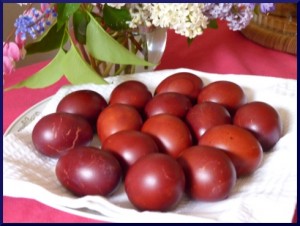It is our tradition to consume (actually, battle with) dyed eggs for Easter Sunday breakfast. These are eggs naturally dyed in the Orthodox tradition using only onion skins. Although I don’t claim to follow lent in any other way, it is a useful period, after pancakes, in order to collect onion skins; sufficient for dying 15 eggs. I don’t know how many onions we consume over that six week period but there always seems to be enough (even this year, when a week of lent was spent away from home). I mix both red and white onion skins, storing them in a plastic bag next to the kitchen compost bin (the skins don’t go mouldy if only dried skins are retained). As you can see the resulting eggs are a lovely mahogany colour (especially after being polished with a little olive oil).
15 organic eggs
Onion skins from around 15 red and/or white onions
2 tbsp vinegar (helps to prevent the eggs cracking)
Olive oil (for polishing)
Put 15 eggs in a single layer in a wide-bottomed pan, set aside (and allow to reach room temperature if they’ve come out of the fridge). Put the onion skins and vinegar in a separate pan and cover with water. Bring to the boil and simmer for 30 minutes. Remove pan from the heat and let cool. Effectively you want to let the dye cool to a temperature where the eggs will not crack when bathed. Pour the dye (and skins) on to the eggs. bring back to the boil and simmer very gently for up to 20 minutes. Remove from the heat. Find and remove the eggs with a slotted spoon and place in bowl of cold water (this makes peeling the eggs easier when you come to eat them). If the eggs have not been sufficiently dyed, return them to the pan of onion dye. Do not re-heat but leave in the dye for an hour or so. Remove eggs. Dab a little olive oil on to a paper towel and polish each egg. Arrange on a plate and consume when cold.
